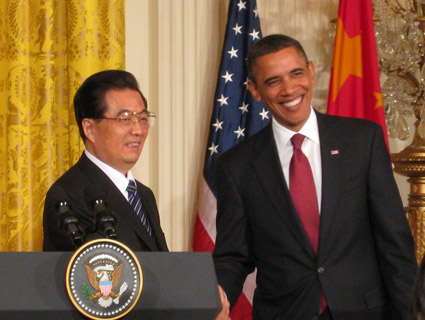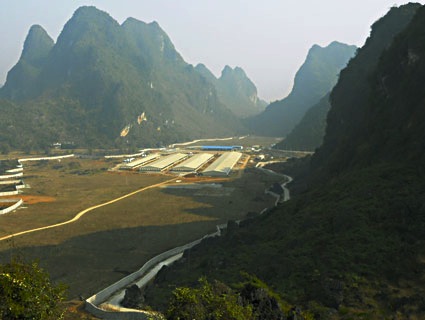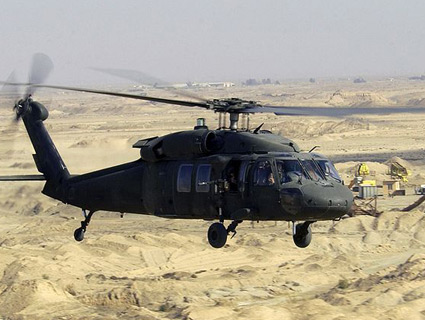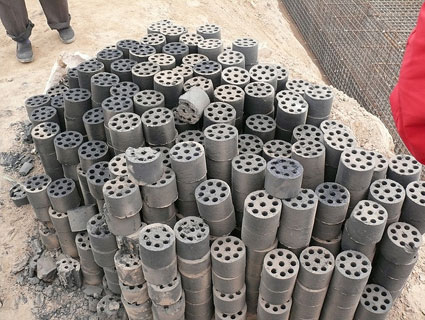
Presidents Barack Obama and Hu Jintao shake hands after a joint press conference at the White House.<a href="http://www.flickr.com/photos/talkradionews/5374703790/in/photostream/">TalkMediaNews</a>/Flickr
This story first appeared on the TomDispatch website.
When it comes to China policy, is the Obama administration leaping from the frying pan directly into the fire? In an attempt to turn the page on two disastrous wars in the Greater Middle East, it may have just launched a new Cold War in Asia—once again, viewing oil as the key to global supremacy.
The new policy was signaled by President Obama himself on November 17th in an address to the Australian Parliament in which he laid out an audacious—and extremely dangerous—geopolitical vision. Instead of focusing on the Greater Middle East, as has been the case for the last decade, the United States will now concentrate its power in Asia and the Pacific. “My guidance is clear,” he declared in Canberra. “As we plan and budget for the future, we will allocate the resources necessary to maintain our strong military presence in this region.” While administration officials insist that this new policy is not aimed specifically at China, the implication is clear enough: from now on, the primary focus of American military strategy will not be counterterrorism, but the containment of that economically booming land—at whatever risk or cost.
The Planet’s New Center of Gravity
The new emphasis on Asia and the containment of China is necessary, top officials insist, because the Asia-Pacific region now constitutes the “center of gravity” of world economic activity. While the United States was bogged down in Iraq and Afghanistan, the argument goes, China had the leeway to expand its influence in the region. For the first time since the end of World War II, Washington is no longer the dominant economic actor there. If the United States is to retain its title as the world’s paramount power, it must, this thinking goes, restore its primacy in the region and roll back Chinese influence. In the coming decades, no foreign policy task will, it is claimed, be more important than this.
In line with its new strategy, the administration has undertaken a number of moves intended to bolster American power in Asia, and so put China on the defensive. These include a decision to deploy an initial 250 US Marines—someday to be upped to 2,500—to an Australian air base in Darwin on that country’s north coast, and the adoption on November 18th of “the Manila Declaration,” a pledge of closer US military ties with the Philippines.
At the same time, the White House announced the sale of 24 F-16 fighter jets to Indonesia and a visit by Hillary Clinton to isolated Burma, long a Chinese ally—the first there by a secretary of state in 56 years. Clinton has also spoken of increased diplomatic and military ties with Singapore, Thailand, and Vietnam—all countries surrounding China or overlooking key trade routes that China relies on for importing raw materials and exporting manufactured goods.
As portrayed by administration officials, such moves are intended to maximize America’s advantages in the diplomatic and military realm at a time when China dominates the economic realm regionally. In a recent article in Foreign Policy magazine, Clinton revealingly suggested that an economically weakened United States can no longer hope to prevail in multiple regions simultaneously. It must choose its battlefields carefully and deploy its limited assets—most of them of a military nature—to maximum advantage. Given Asia’s strategic centrality to global power, this means concentrating resources there.
“Over the last 10 years,” she writes, “we have allocated immense resources to [Iraq and Afghanistan]. In the next 10 years, we need to be smart and systematic about where we invest time and energy, so that we put ourselves in the best position to sustain our leadership [and] secure our interests… One of the most important tasks of American statecraft over the next decade will therefore be to lock in a substantially increased investment—diplomatic, economic, strategic, and otherwise—in the Asia-Pacific region.”
 Such thinking, with its distinctly military focus, appears dangerously provocative. The steps announced entail an increased military presence in waters bordering China and enhanced military ties with that country’s neighbors—moves certain to arouse alarm in Beijing and strengthen the hand of those in the ruling circle (especially in the Chinese military leadership) who favor a more activist, militarized response to US incursions. Whatever forms that takes, one thing is certain: the leadership of the globe’s number two economic power is not going to let itself appear weak and indecisive in the face of an American buildup on the periphery of its country. This, in turn, means that we may be sowing the seeds of a new Cold War in Asia in 2011.
Such thinking, with its distinctly military focus, appears dangerously provocative. The steps announced entail an increased military presence in waters bordering China and enhanced military ties with that country’s neighbors—moves certain to arouse alarm in Beijing and strengthen the hand of those in the ruling circle (especially in the Chinese military leadership) who favor a more activist, militarized response to US incursions. Whatever forms that takes, one thing is certain: the leadership of the globe’s number two economic power is not going to let itself appear weak and indecisive in the face of an American buildup on the periphery of its country. This, in turn, means that we may be sowing the seeds of a new Cold War in Asia in 2011.
The US military buildup and the potential for a powerful Chinese counter-thrust have already been the subject of discussion in the American and Asian press. But one crucial dimension of this incipient struggle has received no attention at all: the degree to which Washington’s sudden moves have been dictated by a fresh analysis of the global energy equation, revealing (as the Obama administration sees it) increased vulnerabilities for the Chinese side and new advantages for Washington.
The New Energy Equation
For decades, the United States has been heavily dependent on imported oil, much of it obtained from the Middle East and Africa, while China was largely self-sufficient in oil output. In 2001, the United States consumed 19.6 million barrels of oil per day, while producing only nine million barrels itself. The dependency on foreign suppliers for that 10.6 million-barrel shortfall proved a source of enormous concern for Washington policymakers. They responded by forging ever closer, more militarized ties with Middle Eastern oil producers and going to war on occasion to ensure the safety of US supply lines.
In 2001, China, on the other hand, consumed only five million barrels per day and so, with a domestic output of 3.3 million barrels, needed to import only 1.7 million barrels. Those cold, hard numbers made its leadership far less concerned about the reliability of the country’s major overseas providers—and so it did not need to duplicate the same sort of foreign policy entanglements that Washington had long been involved in.
Now, so the Obama administration has concluded, the tables are beginning to turn. As a result of China’s booming economy and the emergence of a sizeable and growing middle class (many of whom have already bought their first cars), the country’s oil consumption is exploding. Running at about 7.8 million barrels per day in 2008, it will, according to recent projections by the US Department of Energy, reach 13.6 million barrels in 2020, and 16.9 million in 2035. Domestic oil production, on the other hand, is expected to grow from 4.0 million barrels per day in 2008 to 5.3 million in 2035. Not surprisingly, then, Chinese imports are expected to skyrocket from 3.8 million barrels per day in 2008 to a projected 11.6 million in 2035—at which time they will exceed those of the United States.
The US, meanwhile, can look forward to an improved energy situation. Thanks to increased production in “tough oil” areas of the United States, including the Arctic seas off Alaska, the deep waters of the Gulf of Mexico, and shale formations in Montana, North Dakota, and Texas, future imports are expected to decline, even as energy consumption rises. In addition, more oil is likely to be available from the Western Hemisphere rather than the Middle East or Africa. Again, this will be thanks to the exploitation of yet more “tough oil” areas, including the Athabasca tar sands of Canada, Brazilian oil fields in the deep Atlantic, and increasingly pacified energy-rich regions of previously war-torn Colombia. According to the Department of Energy, combined production in the United States, Canada, and Brazil is expected to climb by 10.6 million barrels per day between 2009 and 2035—an enormous jump, considering that most areas of the world are expecting declining output.
Whose Sea Lanes Are These Anyway?
From a geopolitical perspective, all this seems to confer a genuine advantage on the United States, even as China becomes ever more vulnerable to the vagaries of events in, or along, the sea lanes to distant lands. It means Washington will be able to contemplate a gradual loosening of its military and political ties to the Middle Eastern oil states that have dominated its foreign policy for so long and have led to those costly, devastating wars.
Indeed, as President Obama said in Canberra, the US is now in a position to begin to refocus its military capabilities elsewhere. “After a decade in which we fought two wars that cost us dearly,” he declared, “the United States is turning our attention to the vast potential of the Asia-Pacific region.”
For China, all this spells potential strategic impairment. Although some of China’s imported oil will travel overland through pipelines from Kazakhstan and Russia, the great majority of it will still come by tanker from the Middle East, Africa, and Latin America over sea lanes policed by the US Navy. Indeed, almost every tanker bringing oil to China travels across the South China Sea, a body of water the Obama administration is now seeking to place under effective naval control.
By securing naval dominance of the South China Sea and adjacent waters, the Obama administration evidently aims to acquire the twenty-first century energy equivalent of twentieth-century nuclear blackmail. Push us too far, the policy implies, and we’ll bring your economy to its knees by blocking your flow of vital energy supplies. Of course, nothing like this will ever be said in public, but it is inconceivable that senior administration officials are not thinking along just these lines, and there is ample evidence that the Chinese are deeply worried about the risk—as indicated, for example, by their frantic efforts to build staggeringly expensive pipelines across the entire expanse of Asia to the Caspian Sea basin.
As the underlying nature of the new Obama strategic blueprint becomes clearer, there can be no question that the Chinese leadership will, in response, take steps to ensure the safety of China’s energy lifelines. Some of these moves will undoubtedly be economic and diplomatic, including, for example, efforts to court regional players like Vietnam and Indonesia as well as major oil suppliers like Angola, Nigeria, and Saudi Arabia. Make no mistake, however: others will be of a military nature. A significant buildup of the Chinese navy—still small and backward when compared to the fleets of the United States and its principal allies—would seem all but inevitable. Likewise, closer military ties between China and Russia, as well as with the Central Asian member states of the Shanghai Cooperation Organization (Kazakhstan, Kyrgyzstan, Tajikistan, and Uzbekistan), are assured.
In addition, Washington could now be sparking the beginnings of a genuine Cold-War-style arms race in Asia, which neither country can, in the long run, afford. All of this is likely to lead to greater tension and a heightened risk of inadvertent escalation arising out of future incidents involving US, Chinese, and allied vessels—like the one that occurred in March 2009 when a flotilla of Chinese naval vessels surrounded a US anti-submarine warfare surveillance ship, the Impeccable, and almost precipitated a shooting incident. As more warships circulate through these waters in an increasingly provocative fashion, the risk that such an incident will result in something far more explosive can only grow.
Nor will the potential risks and costs of such a military-first policy aimed at China be restricted to Asia. In the drive to promote greater US self-sufficiency in energy output, the Obama administration is giving its approval to production techniques—Arctic drilling, deep-offshore drilling, and hydraulic fracturing—that are guaranteed to lead to further Deepwater Horizon-style environmental catastrophe at home. Greater reliance on Canadian tar sands, the “dirtiest” of energies, will result in increased greenhouse gas emissions and a multitude of other environmental hazards, while deep Atlantic oil production off the Brazilian coast and elsewhere has its own set of grim dangers.
All of this ensures that, environmentally, militarily, and economically, we will find ourselves in a more, not less, perilous world. The desire to turn away from disastrous land wars in the Greater Middle East to deal with key issues now simmering in Asia is understandable, but choosing a strategy that puts such an emphasis on military dominance and provocation is bound to provoke a response in kind. It is hardly a prudent path to head down, nor will it, in the long run, advance America’s interests at a time when global economic cooperation is crucial. Sacrificing the environment to achieve greater energy independence makes no more sense.
A new Cold War in Asia and a hemispheric energy policy that could endanger the planet: it’s a fatal brew that should be reconsidered before the slide toward confrontation and environmental disaster becomes irreversible. You don’t have to be a seer to know that this is not the definition of good statesmanship, but of the march of folly.
Michael T. Klare is a professor of peace and world security studies at Hampshire College, a TomDispatch regular, and the author, most recently, of Rising Powers, Shrinking Planet. A documentary movie version of his previous book, Blood and Oil, is available from the Media Education Foundation. To listen to Timothy MacBain’s latest Tomcast audio interview in which Klare discusses the American military build-up in the Pacific, click here or download it to your iPod here. To stay on top of important articles like these, sign up to receive the latest updates from TomDispatch.com here.















